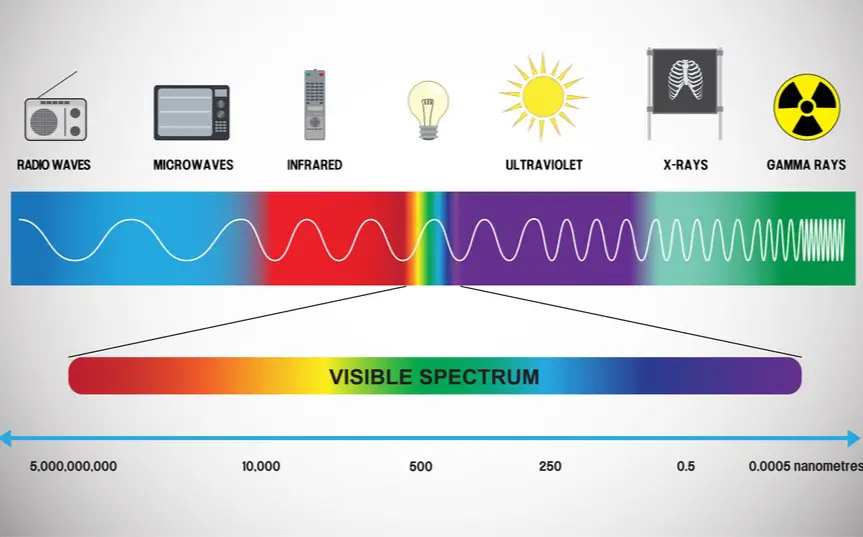
Solar radiation is one of the main sources of energy for our planet, and its influence ranges from the warming of the atmosphere to the processes that enable life on Earth, such as photosynthesis.
However, when we talk about "sun rays," we're talking about something more complex than just the light we see. In reality, the Sun emits radiation in a wide range of wavelengths, which are part of the electromagnetic spectrum .
This spectrum includes different types of radiation, each with unique properties, ranging from low-energy radio waves to high-energy gamma rays.
Before we begin, we will define what solar radiation is and what the electromagnetic spectrum is. Finally, we will explain what the different types of solar rays are in terms of their electromagnetic spectrum.
What is solar radiation?
Solar radiation is the energy emitted by the Sun in the form of electromagnetic waves, which travels through space and reaches the Earth. This radiation includes a wide range of wavelengths, known as the electromagnetic spectrum, ranging from radio waves to gamma rays. The main components of solar radiation that affect the Earth are solar rays in the form of visible light, ultraviolet (UV) radiation, and infrared radiation.
The sun's rays provide light and heat, essential for life on Earth, and also influence climate and the water cycle. Although the atmosphere blocks much of the most harmful radiation, such as UV-C rays, excessive exposure to UV-B rays can have harmful effects on health.
Solar rays are a more colloquial way of referring primarily to visible light reaching the Earth, although sometimes it also includes other forms of solar radiation and many people use this term to refer to solar radiation in general.
The electromagnetic spectrum
 The electromagnetic spectrum is the full range of all forms of electromagnetic radiation that exist. Basically, it is all the energy waves that travel through space.
The electromagnetic spectrum is the full range of all forms of electromagnetic radiation that exist. Basically, it is all the energy waves that travel through space.
This spectrum ranges from radio waves, which are the longest and lowest in energy, to gamma rays, which have the shortest wavelengths and are extremely energetic. In between these extremes, we also find microwaves, infrared radiation (which we feel as heat), visible light (which our eyes can see), ultraviolet radiation (which can cause sunburn), and X-rays.
Solar radiation spans a wide range of wavelengths within the electromagnetic spectrum . The electromagnetic spectrum is like a "rainbow" of energy waves, and ranges from radio waves, which have very long wavelengths, to gamma rays, which have extremely short wavelengths.
To better understand the types of solar radiation, let's divide the spectrum into the following main parts:
- Ultraviolet (UV) radiation
- Visible light
- Infrared radiation (IR)
Sun rays and photovoltaic energy
Photovoltaic panels capture mainly visible light and part of the infrared (IR) radiation from the electromagnetic spectrum. These radiations contain the energy that the panels convert into electricity through the photovoltaic effect.
The material in solar cells, usually silicon, absorbs photons of these wavelengths and converts them into electric current.
Although ultraviolet (UV) radiation also reaches the Earth, its contribution to electricity generation is minimal, since most of the usable energy comes from visible and infrared light.
Type 1: Ultraviolet (UV) radiation
 Ultraviolet radiation , or UV radiation, is a form of solar energy that has a shorter wavelength than visible light. Although we can't see it, it's there, and it has very important effects on Earth and humans.
Ultraviolet radiation , or UV radiation, is a form of solar energy that has a shorter wavelength than visible light. Although we can't see it, it's there, and it has very important effects on Earth and humans.
UV radiation can be divided into three types according to its wavelength:
- UV-A (315-400 nm) : This is the least energetic and most abundant type of UV radiation reaching the Earth. Although it can penetrate the skin, it is not as dangerous as other types of UV. However, prolonged exposure can contribute to skin aging and eye damage, such as cataracts.
- UV-B (280-315 nm) : This is more energetic than UV-A and can cause sunburn and DNA damage to skin cells. In fact, it is the type of radiation most closely linked to skin cancer. Fortunately, the atmosphere, especially the ozone layer, blocks much of the UV-B rays.
- UV-C (100-280 nm) : This is the most dangerous form of ultraviolet radiation, as it has the most energy. Fortunately for us, virtually all UV-C radiation is absorbed by the ozone layer and does not reach the Earth's surface. Otherwise, it would be very harmful to living organisms.
UV radiation has a direct impact on the health of humans and other organisms. Although we need a certain amount of UV-B light to produce vitamin D, excessive exposure can cause problems such as sunburn, premature skin aging, and an increased risk of skin cancer. In addition, UV radiation can affect aquatic ecosystems and damage phytoplankton, which is an important foundation in the marine food chain.
Type 2: Visible light
 Visible light is, as its name suggests, the part of solar radiation that we can see. It represents only a small portion of the electromagnetic spectrum, with wavelengths ranging from about 380 nanometers (nm) to about 750 nm. Many people refer to visible light as solar rays.
Visible light is, as its name suggests, the part of solar radiation that we can see. It represents only a small portion of the electromagnetic spectrum, with wavelengths ranging from about 380 nanometers (nm) to about 750 nm. Many people refer to visible light as solar rays.
Visible light includes all the colours we can see in a rainbow, from violet (shortest wavelength) to red (longest wavelength). Within this range, solar radiation provides the light that illuminates our world and makes it possible for us to see objects.
Visible light is essential for life on Earth, not only because it allows us to see, but also because plants use it in the process of photosynthesis. Through photosynthesis, plants capture solar energy and convert it into chemical energy, stored in the form of glucose.
Type 3: Infrared radiation (IR)
Infrared radiation is found just after visible light on the electromagnetic spectrum, with wavelengths ranging from 750 nm to about 1,000,000 nm (or 1 millimeter). Although we cannot see infrared radiation, we can feel it in the form of heat.
There are three types of infrared radiation:
- Near-infrared (IR-A, 750-1400 nm) : This is the infrared radiation closest to visible light. Although we cannot perceive it, certain devices, such as thermal cameras, can detect this form of radiation. It is used in remote controls and infrared communication systems.
- Mid-infrared (IR-B, 1400-3000 nm) : This has a longer wavelength and is the radiation most commonly associated with heat. When we are in the sun, the sensation of heat we feel comes largely from infrared radiation.
- Far infrared (IR-C, 3000 nm-1 mm) : This is the infrared radiation emitted by warm bodies, including ourselves. All objects that have a temperature emit infrared radiation, and the warmer the object, the more intense this radiation.
Infrared radiation is key to the greenhouse effect, a natural process that keeps the Earth's temperature at a level suitable for life.
Greenhouse gases such as carbon dioxide (CO2) and water vapor trap some of the infrared radiation that Earth emits, keeping the planet warm. Without this process, Earth would be a much colder and more inhospitable place.